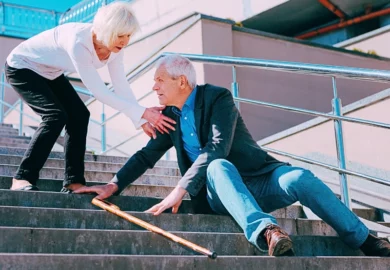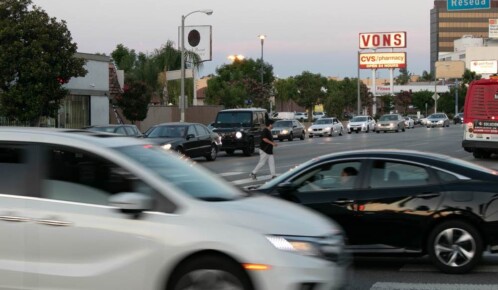Chicago’s iconic landmarks—Navy Pier, Millennium Park, the Field Museum, the Art Institute, and the Magnificent Mile—attract millions of visitors annually. These destinations offer unparalleled experiences. Unfortunately, many hazards can lead to slip and falls at Chicago’s top attractions, turning a fun adventure into a painful trip to the E.R.
Table of Contents

If you’ve experienced a slip and fall injury while visiting one of Chicago’s top spots, understanding your rights is crucial. Call Ankin Law at 312-600-0000 now. Consults are free.
Common Causes of Slip and Falls at Chicago Attractions
Slip and fall accidents can occur for various reasons, particularly in high-traffic areas like Chicago’s tourist destinations. The following are common causes of these accidents.
Wet or Slippery Surfaces
One of the most common causes of slip and fall accidents in public spaces is wet or slippery surfaces. This can occur after rain, snow, or spills inside or around venues like museums, theaters, or restaurants. In these environments, the property owner or manager has a responsibility to maintain the premises and ensure that the floors are dry and safe for visitors.
Uneven Pavement or Flooring
Cracked, uneven sidewalks or floors can easily cause someone to trip. Tourists often walk around unfamiliar areas and may not notice hazardous conditions. For example, along Chicago’s iconic Magnificent Mile or in parks like Millennium Park, an unexpected change in pavement height could lead to an injury. Property owners must address these hazards promptly to prevent accidents.
Poor Lighting
Poor visibility is another common factor contributing to slip and fall accidents. If a pathway or stairway is poorly lit, it can be difficult for visitors to spot hazards. Many popular attractions, including outdoor spaces like Navy Pier, are at risk during the evening or night hours. Illumination plays a key role in preventing accidents, and inadequate lighting can make it harder for individuals to avoid hazards.
Obstacles and Clutter
Falling objects or obstacles left in walkways can pose a significant risk, particularly in crowded spaces. In attractions such as the Field Museum or the Art Institute of Chicago, visitors may be distracted by exhibits and fail to notice the dangers in their path. These hazards should be swiftly addressed to avoid accidents.
Inadequate Signage and Warnings
Visitors to Chicago’s attractions often face unexpected hazards because of a lack of proper warnings. Whether it’s a wet floor sign or a cautionary warning for an uneven surface, property owners must post clear signs to warn visitors about dangers. When these signs are absent or insufficient, the risk of accidents increases.
Notable Incidents at Chicago Attractions
Over the years, there have been numerous slip and fall accidents at popular destinations in Chicago. Some of the most notable include:
Navy Pier
In one tragic case, the parents of an 8-year-old boy filed a lawsuit against Navy Pier after their son fell 24 feet from a climbing wall. The lawsuit alleged that the workers failed to properly secure the child’s harness, leading to severe injuries. This incident highlights the importance of adhering to safety protocols, especially in attractions involving physical activities.
Millennium Park
Millennium Park has also been host to many slip and fall accidents. Visitors sometimes slip on various surfaces within the park, leading to injuries. Additionally, the park has been the site of other incidents, including electrocution injuries from malfunctioning electrical fixtures and violent attacks. These occurrences underscore the need for vigilance and proper maintenance in public spaces.
Starved Rock State Park
In April 2025, a Tinley Park woman and her 7-year-old son fell approximately 30 feet while walking along a trail at Starved Rock State Park – just a short drive from Chicago. According to NBC Chicago, the son slipped, and when the mom tried to grab him, she fell into the French Canyon along with him. Both mother and son were airlifted to an area hospital with non-life-threatening injuries. Utica Fire Protection District Chief Ben Brown said authorities receive 3–4 calls to the park per year involving falls.
The Legal Responsibilities of Property Owners
In Chicago, property owners and managers are legally obligated to maintain a safe environment for visitors. This is especially true for those managing high-traffic public spaces. If you’ve been injured at one of Chicago’s top attractions, it’s important to know that the law holds property owners accountable for maintaining their premises in reasonably safe condition.
Duty of Care
Property owners must meet a duty of care, which requires them to address known hazards and maintain safe conditions. This could mean repairing uneven flooring, clearing away obstacles, or addressing weather-related hazards like icy walkways. Failure to fulfill this duty is considered negligence and can serve as the basis for a personal injury claim.
Premises Liability
Premises liability refers to the legal responsibility of property owners to prevent harm to people on their property. If an accident occurs because the owner failed to address unsafe conditions, the injured party may be able to pursue compensation through a premises liability lawsuit. To succeed, the injured person must demonstrate that the property owner or manager was negligent in maintaining the property.
Common Injuries from Slip and Fall Accidents
Slip and fall accidents can result in a wide range of injuries, from minor scrapes to life-altering conditions. Some of the most common injuries sustained during slip and fall accidents at Chicago’s top attractions include:
1. Broken Bones
Fractures are common, particularly when a person falls forward or backward and lands on their hands, wrists, or legs. Broken bones often require medical treatment, including surgery or rehabilitation.
2. Head Injuries
Head injuries, including concussions, are common in slip and fall accidents — especially falls from heights. Falls that result in a blow to the head can cause long-term damage and may require ongoing medical treatment.
3. Back and Spinal Injuries
Falls can result in serious injuries to the back and spine, leading to chronic pain or even paralysis in severe cases. These injuries often require extensive medical care and long-term treatment.
4. Sprains and Strains
Injuries to muscles, tendons, or ligaments, such as sprains and strains, are also common. While not always as severe as fractures or head injuries, these injuries can be painful and lead to significant time off work or other activities.
Seeking Compensation After a Slip and Fall Injury
If your injury occurred due to the negligence of a property owner or manager, you may be entitled to compensation. This can cover a wide range of damages, including:
- Medical Expenses: Costs associated with treatment, surgery, and rehabilitation.
- Lost Wages: If your injury caused you to miss work, you may be entitled to compensation for your lost income.
- Pain and Suffering: Compensation for physical and emotional pain caused by the injury.
- Punitive Damages: In some cases, if the property owner’s actions were egregiously negligent, punitive damages may be awarded as a form of punishment.
How Ankin Law Can Help
At Ankin Law in Chicago, our experienced personal injury attorneys represent victims of slip and fall accidents at Chicago’s top attractions. If you’ve been injured due to negligence, we can help you understand your rights and make sure you recover maximum compensation for your losses.



